Vegan Pie Crust
This easy Vegan Pie Crust Recipe creates a crispy, buttery pie crust perfect for your next vegan pie. You can master this easy flaky crust using only 7 ingredients. It begins with the perfect vegan pie dough, made with my favorite secret ingredient!
You’ll love filling this pie crust with a Vegan Chocolate Pie Filling topped with Vegan Meringue. It’s not only delicious, but it’s beautiful too!
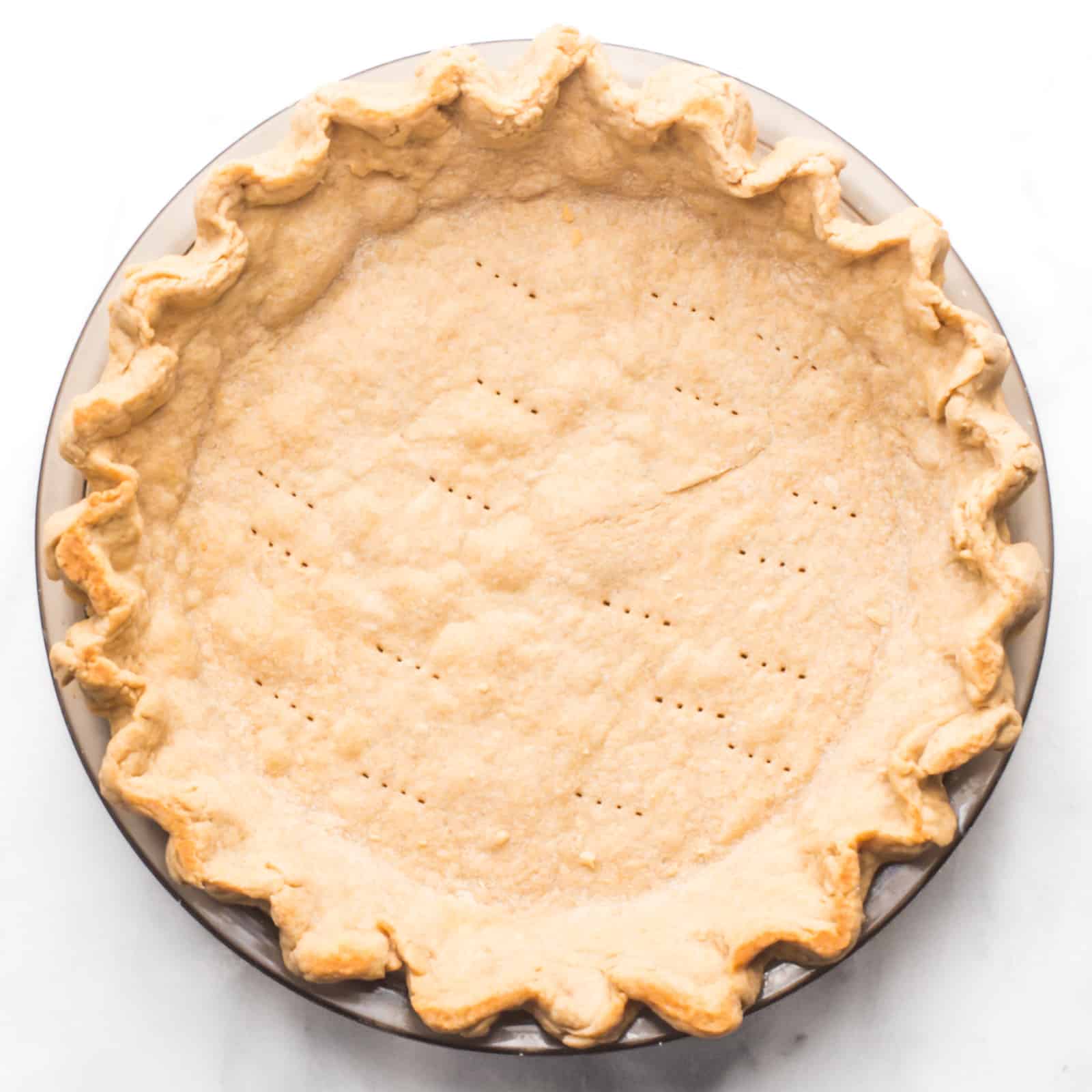
One of the most important parts of any pie is having a perfect pie crust. That’s not rocket science. But the really tricky part is making a simple pie crust that results in a flaky crust, suitable for any pie filling.
This recipe walks you through step-by-step so you can make a delicious vegan pie crust from scratch!
This is my time-tested vegan pie crust recipe. In fact, I’ve been using (and refining) this recipe for years.
What Makes This Recipe Shine?
- Using both vegan butter and vegetable shortening creates a flaky crust with the best buttery flavor
- Adding vodka makes the batter extra flaky because most of the alcohol evaporates in baking, leaving behind the best crust texture
- Keeping the ingredients cold helps to bake a perfect crust time and time again!
Pie Crust Ingredients
You can find the full printable recipe, including ingredient quantities, below. But first, here are some explanations of ingredients and steps to help you make this recipe perfect every time.
This vegan pie crust is made with only a few simple ingredients:
- Flour — You can also use all-purpose flour or whole wheat pastry flour (not the same as whole wheat flour)
- Salt — salt brings out the flavor in this crust.
- Sugar — I’m recommending a bit of sugar because sugar helps to prevent the formation of gluten in the flour, making for a more tender crust.
- Fat — We’ll use a mixture of vegan butter and shortening. The butter adds the best flavor, but the shortening adds the flakiness.
- Liquid — You have to have liquid in the dough to hydrate the flour and bind everything together. In addition, the liquid and the fat creates steam in the baking process, creating lift in the baked crust. I recommend a combination of chilled vodka and water. See more on why I’m using vodka below.
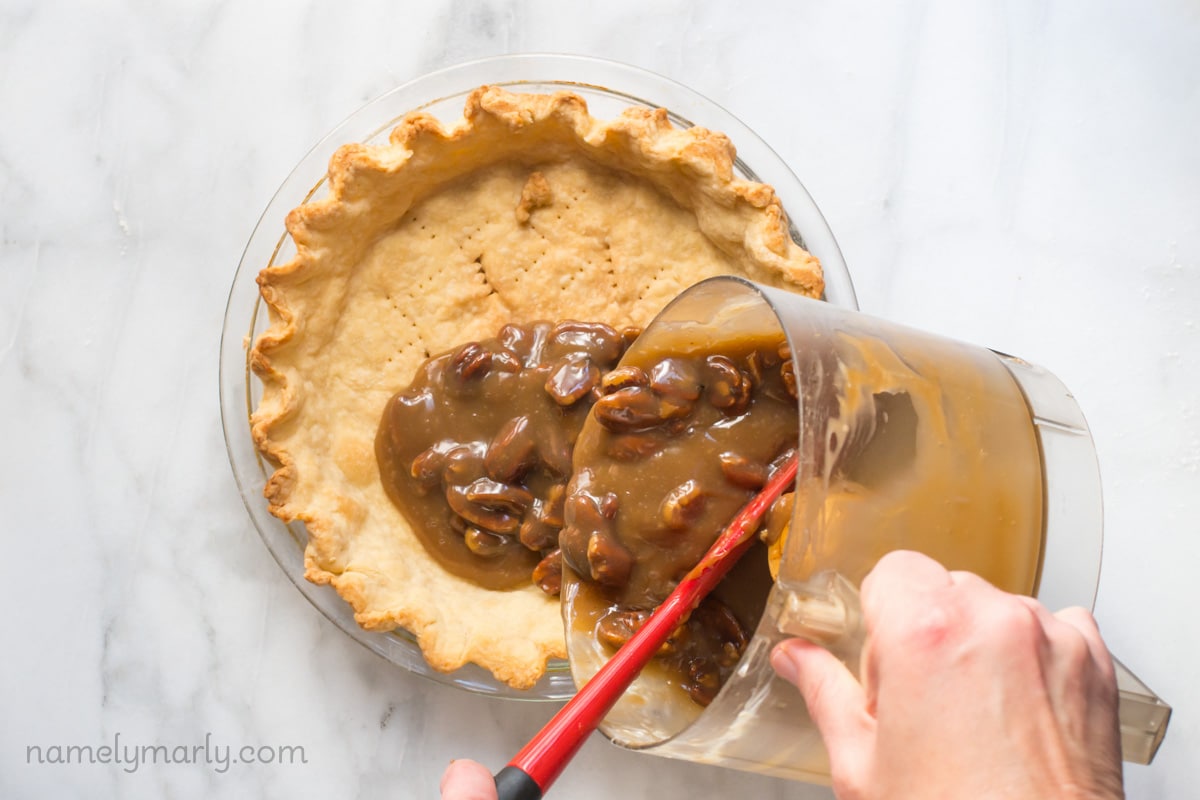
Use Cold Ingredients in Pie Crusts
Keeping your pie dough ingredients — like the fat and liquids — as cold as possible prevents the fat in the unbaked pie from getting soft. If the fat gets soft and melty in the dough before baking, you can say bye-bye to a flaky crust.
However, using chilled fat helps it stay intact in the dough. Then as the pie bakes, the lumps of fat melt in the oven and produce steam. That steam helps creates micro-layers of flakiness. I think this may have been what my sisters called me when I was a kid, but I digress.
So, think of it this way, a warm dough will yield a hard, greasy crust, whereas a cold dough will yield a tender, flaky vegan pie crust.
How to Make Vegan Pie Crust
First things first, I like to use a food processor to make my pie crust. It makes it easier to get the vegan butter evenly distributed throughout the flour.
Here’s the dilemma: If you over-process your dough, it can overwork the gluten in the flour, resulting in a chewy crust. You also want big bits of butter throughout the crust, because that’s what makes it flaky. So, just be sure to use the processor in short bursts.
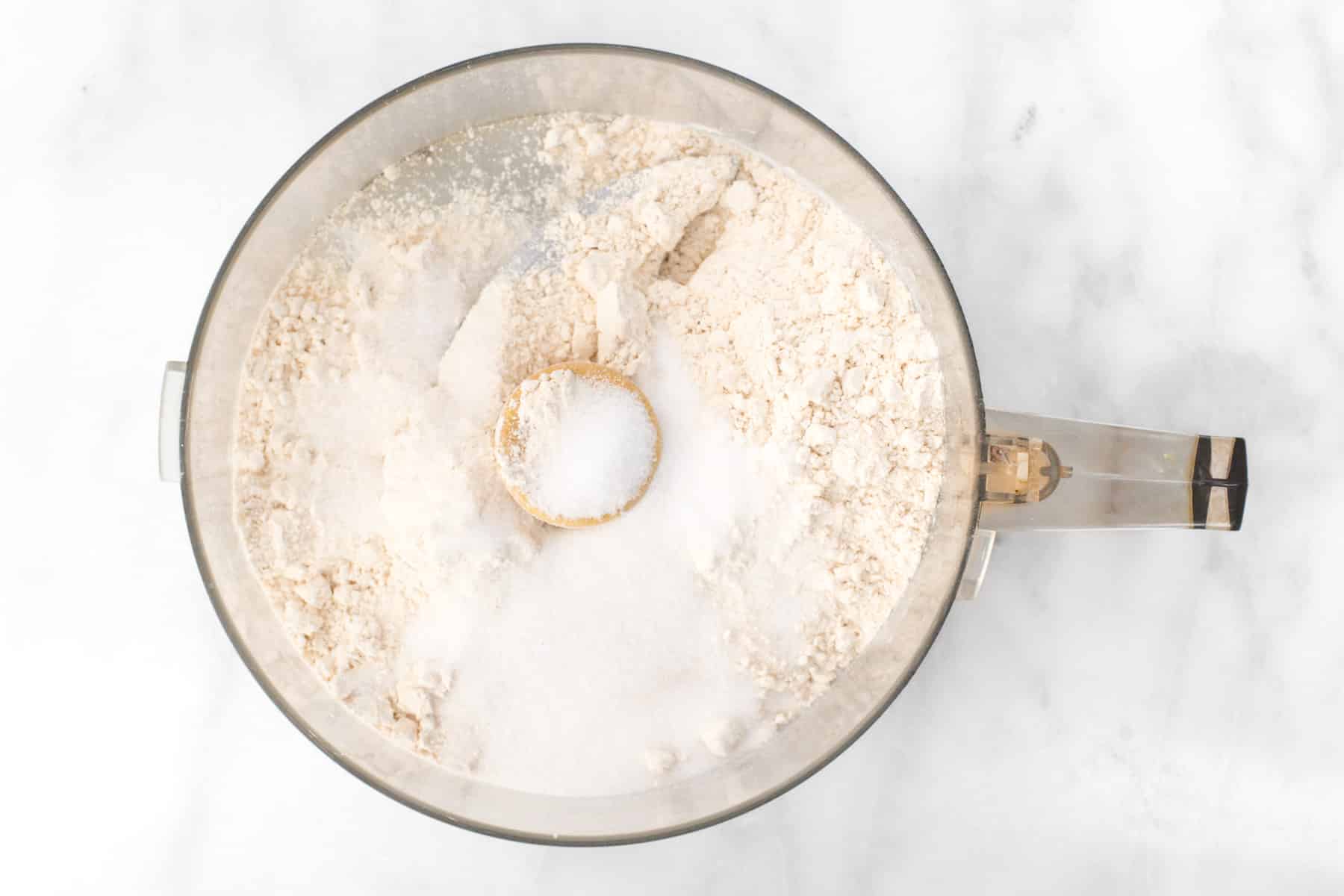
Step One: Mix Dry Ingredients
Combine the flour, salt and sugar in the food processor and give it a few pulses to combine.
I’ve made this vegan pie crust recipe using both all-purpose (unbleached) flour and whole wheat pastry flour. It works both ways. So you can replace the flour below with 100% whole wheat pastry flour or some combination of the two and still achieve a nice, flaky vegan crust.
Step Two: Cut in the Fat
Store both the vegan butter and vegetable shortening in the fridge (or even the freezer) for about 30 minutes prior to making your crust. Why? Because you want bits of fat distributed throughout the dough and working with cold fat helps achieve that.
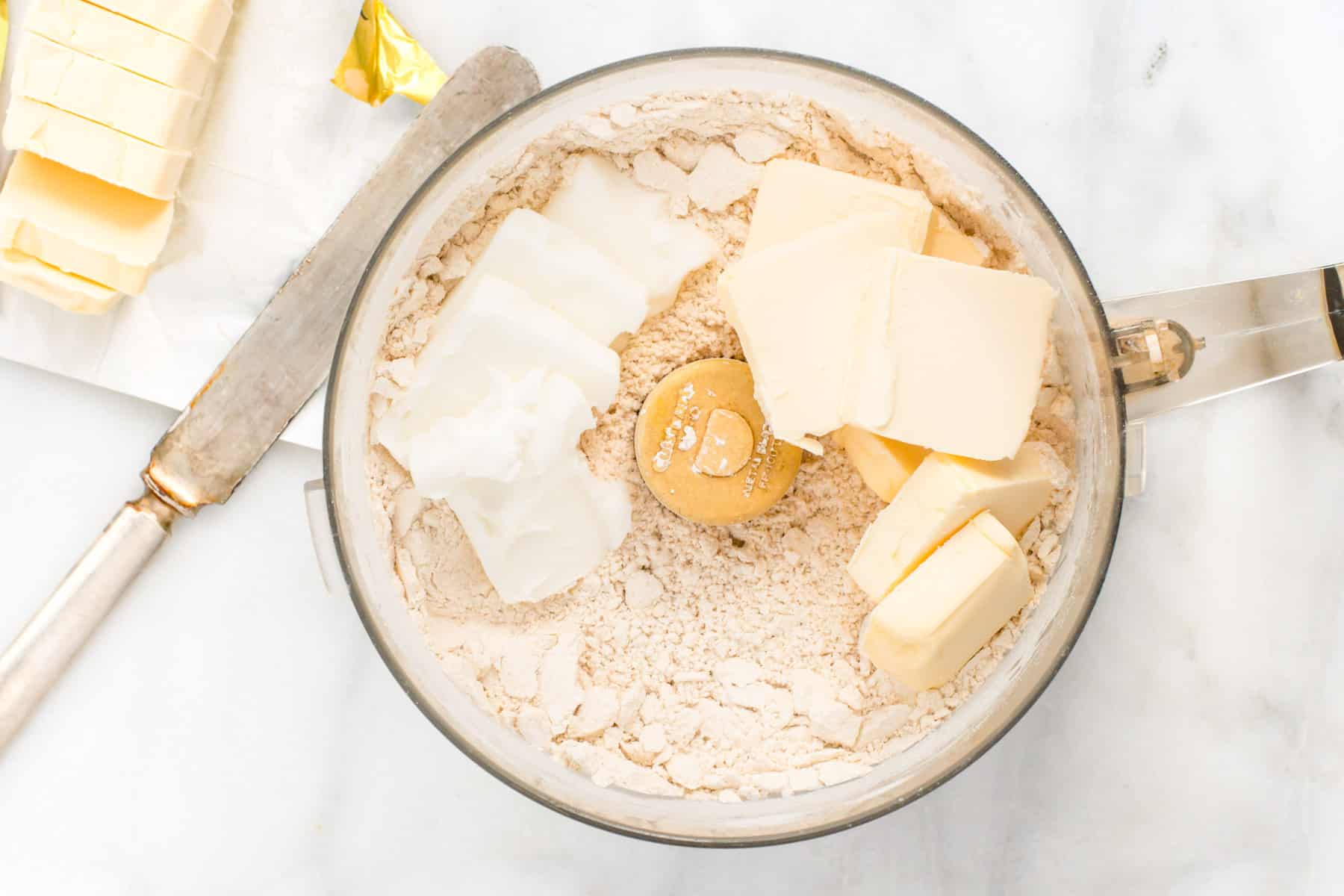
Chop the cold vegan butter and shortening, and then add these slices to the flour mixture. After a few pulses, the fat should be equally distributed throughout the dough.
Step Three: Add Liquid
When you add liquid to all-purpose flour it immediately begins activating the gluten. That’s one reason I’m using equal parts of water and vodka. I learned about this trick from 101 Cookbooks. Heidi recommends including a little vodka because it helps make the pie dough to be more malleable and flakier.
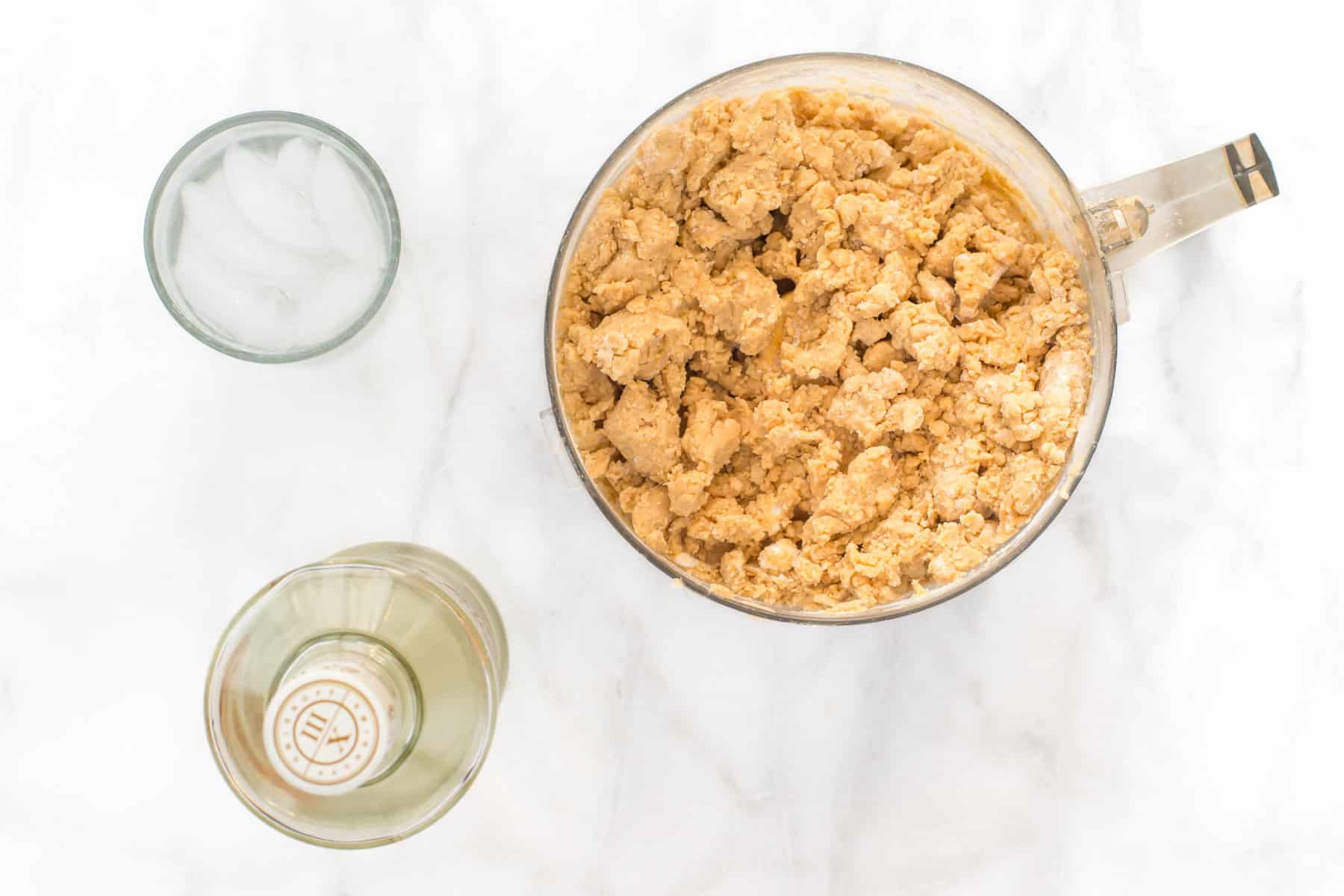
To chill the water and vodka, pour it into a glass with ice. Then measure it out and pour it over the crust.
Sprinkle the cold vodka over the pie dough and stir until combined. Next, add the chilled water, 1 tablespoon at a time, until the dough is slightly tacky and sticks together.
Step Four: Cover and Chill
This is a double pie crust recipe, so once your dough is ready, divide it in half and roll the dough into discs. Then wrap it in plastic wrap and chill in the fridge for 30 minutes or up to 3 days. Or you can freeze it where it will last up to 2 months!
I love having a disk of frozen pie dough in the freezer for those spur of the moment times when I want to make a pie.
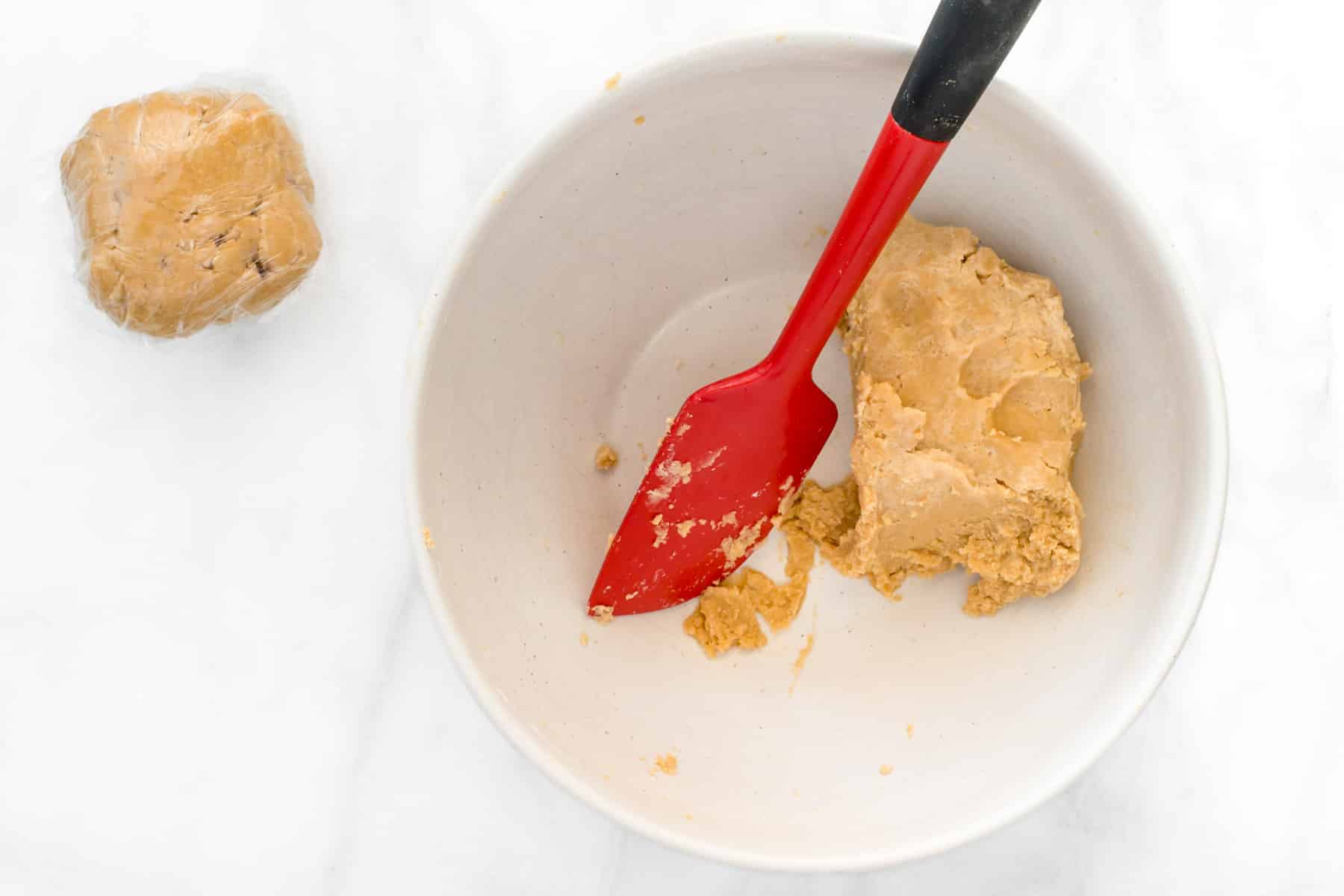
Divide the pie dough recipe in half and wrap in plastic wrap and chill before rolling.
That chilling step is important because it helps create a firm dough and makes rolling it much easier.
Step Five: Follow your Pie Instructions
The next step is to follow your specific pie recipe instructions. For example, a vegan pumpkin pie will call for an unbaked vegan pie crust. In that case, you would roll out the dough, place it in the pie pan, and crimp the edges. Once the filling is ready, pour it in the unbaked pie shell and bake it all together.
Alternatively, a chocolate pudding pie usually calls for a baked pie crust. In that case, you would roll out the dough, place it in a pie pan, crimp the edges, prick the bottom of the pie with a fork, and bake the crust. I oftentimes will add pie weights to the crust while baking it so that the crust doesn’t develop bubbles as its baking.
Don’t have pie weights? Add a sheet of parchment paper over the unbaked crust and top that with some dried beans. I’ve done this and it works!
How to Roll Pie Crust
To roll out pie dough, begin by lightly flouring a surface or you can roll the dough between two sheets of waxed paper.
Either way, just remember to be gentle when rolling your dough. Using a rolling pin, always start from the center of the disc and roll out away from the center. This requires turning the dough frequently. So roll, and turn, then roll and turn. You get the idea.
For a standard 9″ inch pie pan, roll the dough 11–12″ in diameter. Yes, I keep a ruler in the kitchen. Or you can get a pie rolling sheet that gives dimensions.
Then transfer the dough into the pie pan and trim and flute the edges.
Is Crisco Vegan?
Basically, shortening is a fat that is firm at room temperature. Most shortenings, such as Cristco, are made from vegetable oil and are therefore vegan. However, read the label to make sure your shortening is made without animal products like lard. Shortening is often recommended for pie crusts because it helps make them crispy and flaky.
Marly’s Tips
- The first thing to remember when you’re making a flaky pie crust is you want to use as little liquid as possible
- I use a combination of both vegan butter (Earth Balance) and vegetable shortening. The vegan butter creates a buttery flavor in the pie crust
- Use a vegan butter that’s firm when cold. If it’s overly spreadable, it will not work for a pie crust.
- Using shortening is an easy way to make a flaky vegan pie crust. However, you can substitute coconut oil
- You can substitute vinegar if you prefer not to use vodka
- Once the dough balls are prepared, you can freeze the dough at that point. Simply place them in a sealed container or in a freezer bag and freeze up to 1 month. Before rolling, allow them to sit on the counter and thaw, about 45 minutes to an hour.
How Do You Make a Flaky Pie Crust?
Pie dough involves pockets of fat surrounded by hydrated flour. We’ll be using a food processor to cut the fat into the flour and then roll it out to make a pie crust. While that crust is baking, it gets flaky because of the layers of fat and hydrated flour throughout the dough.
The best trick to making a flaky vegan pie crust is to minimize the amount of moisture used, while still having enough stickiness to roll it. Using minimal liquids helps create the flakiest pie crust possible. That’s why my favorite trick involves alcohol.
Vodka adds moisture to the pie dough, allowing it to be malleable enough to work with. Of course, most of it bakes off in the oven, leaving a nice, flaky crust.
Vegan Pie Crusts
There are lots of different vegan pie crusts. Let’s discuss some of the options you have for your next vegan pie. For example:
- This Oatmeal Pie Crust is simple to make and undeniably flavorful
- You can create your own Oreos crust, like this one using Golden Oreos, Vegan Banana Cream Pie
- Here’s a healthy, raw pie crust using nuts and dried fruit that is more like a vegan tart: Chocolate Pie Pastry Recipe
- Or you can make a vegan graham cracker crust like this one, Vegan Cheesecake recipe
- You can’t go wrong with a flaky crust like this one. This Vegan Pecan Pie recipe shows how to bake your crust with a custard.
So, you see, there are lots of vegan pie crust recipes, including some healthier versions too.
That’s our post for Vegan Pie Crust. Use the recipe below to make your own and stay tuned because there are some pretty fabulous pie recipes coming your way this week.
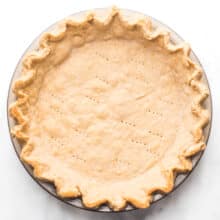
Foolproof Flaky Vegan Pie Crust
Ingredients
- 2 ½ cups unbleached all-purpose flour , divided
- 1 teaspoon salt
- 2 tablespoons granulated sugar
- 8 tablespoons (1 stick) vegan butter cut into slices
- 4 tablespoons vegetable shortening cut into pieces
- ¼ cup cold vodka
- ¼ cup cold water
Instructions
- Pour 1 1/2 cups flour, salt, and sugar into a food processor and pulse until combined, about 2 seconds.
- Add vegan butter and process until just combined. Add the shortening slices and pulse until dough collects in clumps, about 15 seconds.
- Add remaining cup of flour and pulse until mixture is evenly distributed (4 to 6 quick pulses). Empty mixture into a medium bowl.
- Sprinkle cold vodka over the dough and stir until combined. Add water, 1 tablespoon at a time until the dough is slightly tacky and sticks together.
- Divide dough into two even balls and flatten each into a 4-inch disk. Wrap each in plastic wrap and refrigerate for at least 30 minutes or up to 3 days. These dough balls can be frozen too. Place in freezer bags and freeze up to 1 month. When you're ready to make the pie, set it out on the counter to thaw for about an hour before rolling.
- From this point, follow the directions for your pie recipe. Some pie recipes will require pouring the custard into an unbaked pie crust whereas others will require baking the crust prior to pouring in the custard.
Recommended Equipment
(The products above contain sponsored links to products we use and recommend)
Notes
The nutrition information shown is an estimate provided by an online nutrition calculator and should not be considered a substitute for a professional nutritionist’s advice.
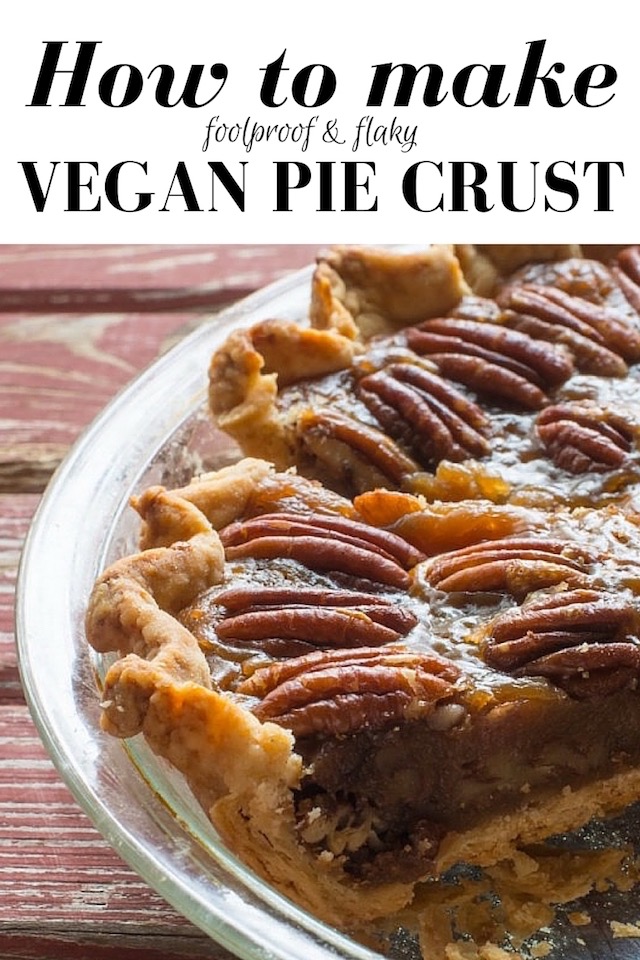
Enjoy!
This post was originally published in 2015 and was updated to include new photos, new text, and an updated recipe in 2020.
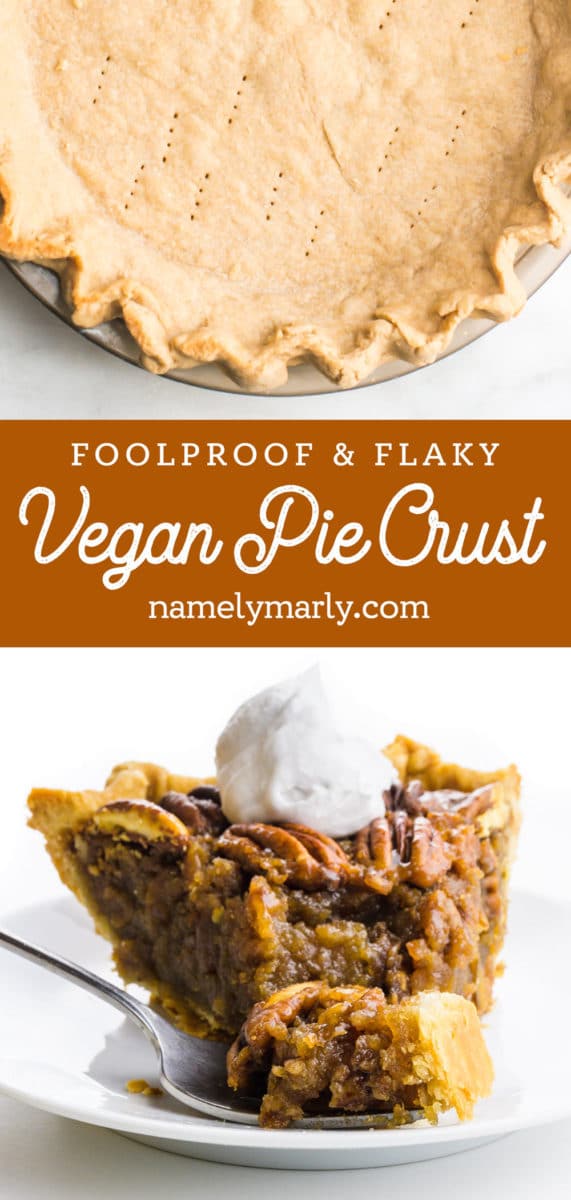
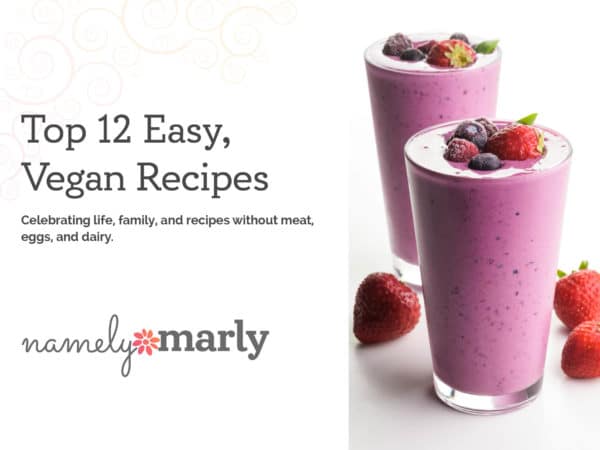
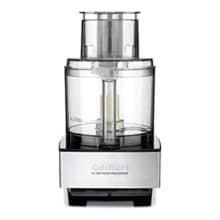
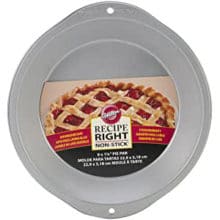
Hi, Marly! I’m about to try this recipe, and it’s VERY similar to the American’s Test Kitchen double-crust vodka pie crust recipe (which has worked famously for me) except for the percentage of fat. The ATK recipe calls for 12 tablespoons butter and 1/2 cup shortening, whereas yours calls for 8 tablespoons vegan butter (I’m using Earth Balance) and 1/4 cup vegetable shortening. That’s quite a difference: 20 tablespoons fat vs. 12. I’m certainly game to give it a go, but I was wondering why your recipe calls for 40 percent less fat and how it still works for the same amount of crust. Thanks!
Hi Jo. I’m not familiar with the ATK pie crust recipe. I got the idea for adding vodka from a cookbook I read a long time ago. I adapted this recipe over the years and this has been my go-to favorite for years. I hope you enjoy it as well!
I’ve never made a pie crust before and for some reason, this recipe grabs me (I swear it’s not the vodka, but…)
My first project is going to be a vegan vegetable pie -so here’s a newb question:
Is there any reason I shouldn’t use this recipe?
And general advice if you don’t mind:
Should I bake the crust first to stop it from getting soft on the bottom?
TIA!
Hi Greg. Any recipe that includes vodka gets my immediate attention, too! 🙂 I actually made a vegan pot pie and I used this pie crust recipe and it worked like a charm! Also, I did not prebake the pie crust before adding the filling. I recommend using one of the dough discs as a bottom crust and the other as a top crust. I also brushed vegan egg wash over the top to make the top crust and the edges nice and golden in color. I hope this is helpful, but feel free to let me know if you have more questions.
Used 1/2cup rum and 1/4 cup distilled vinegar,instead ,no water and cultured vegan butter .Then half succanat and half cane sugar. And some extra flour for dusting and whoa! ,Best pie crust ever!
Hi Kathleen. I like your adjustments and I’m so glad it came out perfectly for you!
Great tasting and simple recipe for dairy free gluten free pecan pie. I’ve made it three times already. Thank you.
Thanks, Wade. So glad you like this recipe. I almost always have some in my freezer. You know, for those moments you want to make an impromptu pie! 🙂
Hi Marly,
Can you use gin instead of vodka? I’m trying to avoid buying a whole bottle and instead use what I have! Or if not, what kind of vinegar do you recommend? ACV? Thank you!
Hi Chelsea. There are a lot of similarities between gin and vodka, but gin has more flavor (it’s made with juniper berries) which may come through in the pie crust. I would recommend going with vinegar, such as apple cider vinegar (as you note). It has the mildest flavor in my opinion.
This is the best pie crust I’ve ever made and it was easy too. Thanks!
This is the first vegan pie crust recipe that has really worked (in terms of being flaky and super tasty)! I followed the recipe exactly, but did everything by hand. Thank you 🙂
Hi Darla! So glad you liked this vegan pie crust recipe. I’m so glad to see you made it by hand too!
Do I have to use shortening? Can I replace with all vegan butter?
Hi Mette! Yes, you can use all vegan butter. Or you can do coconut oil as well. I’ll add these as notes to the recipe.
I made this without the sugar But everything else the same, and by hand with a manual dough cutter, it came out perfect for chicken pie and chicken pot pie!!
Alcohol does not completely “burn off” in cooking. While I know that 1/4 cup of vodka is unlikely to cause problems for anyone when distributed through an entire recipe, it is important to stop this fallacy.
https://oasas.ny.gov/news/alcohol-and-cooking
The USDA has tested this and compiled this chart that is widely used by those with addiction problems and those who treat them.
(Editor’s note: The link listed above was changed from what the commenter originally submitted because that link quit working. The link above seems to be pointing to the same information as was intended by the commenter).
Hi CarolAnn. Thank you for your very kind note. I agree that it’s important to give accurate information. My dad was an alcoholic and eventually gave up drinking in his 60’s. I’ll reference this article from The Spruce Eats discussing how alcohol burns off in cooking. Please note, they also reference the USDA chart as well. Here’s a quote from that article: “…take a liquor that is 100-proof. This means it is 50 percent alcohol by volume. So a baked and/or simmered dish with 2 ounces (1/4 cup) of 100-proof liquor cooked for 1 hour will have 12.5 percent alcohol content remaining, about 1/4 ounce. Divide that by the amount of servings, and the quantity goes down proportionately (.0625 ounces per each of 4 servings).”
Typically vodka is more like 80-proof so these numbers can be reduced as a result. Obviously, it will depend on the amount of time the pie crust is baked, but for pies like pumpkin pie or pecan pie, they’re in the oven over an hour.
I hope this information is helpful. Thanks again. Marly